Russound IW-620 Handleiding
Bekijk gratis de handleiding van Russound IW-620 (11 pagina’s), behorend tot de categorie Speaker. Deze gids werd als nuttig beoordeeld door 83 mensen en kreeg gemiddeld 3.7 sterren uit 42 reviews. Heb je een vraag over Russound IW-620 of wil je andere gebruikers van dit product iets vragen? Stel een vraag
Pagina 1/11

a sound relationship
ussoun
ARCHITECTURAL
SPEAKERS
Guide
To
Products and Installation
0
Ru1nrc1
0
0
0
0
0
0
0 0
IW-620/IW-630
Thank you for choosing your speakers from Russound's Architectural
Series
of
premium loudspeakers.
They've been designed, manufactured and
tuned
with
great
care
so
your listening experience
is
as
rewarding
as
possible. This range
of
speaker solutions provides excellent choices
for
any application
- from budget-minded
to
audio-purist. They provide perfect choices for multi-room audio, home
theater, primary listening and other applications.
These
new
speakers incorporate
the
latest advances
in
material technologies
as
well
as
engineering
innovation and design excellence. For example,
on
the
step-up models, you'll
find
the
Swiftloclc-
tool-
less
installation feature
to
be
a brilliant means
to
accomplish secure installations simply and easily.
We wish you many
years
of
musical enjoyment from your Russound speakers, indoors, outdoors
or
wherever your entertainment needs take you.
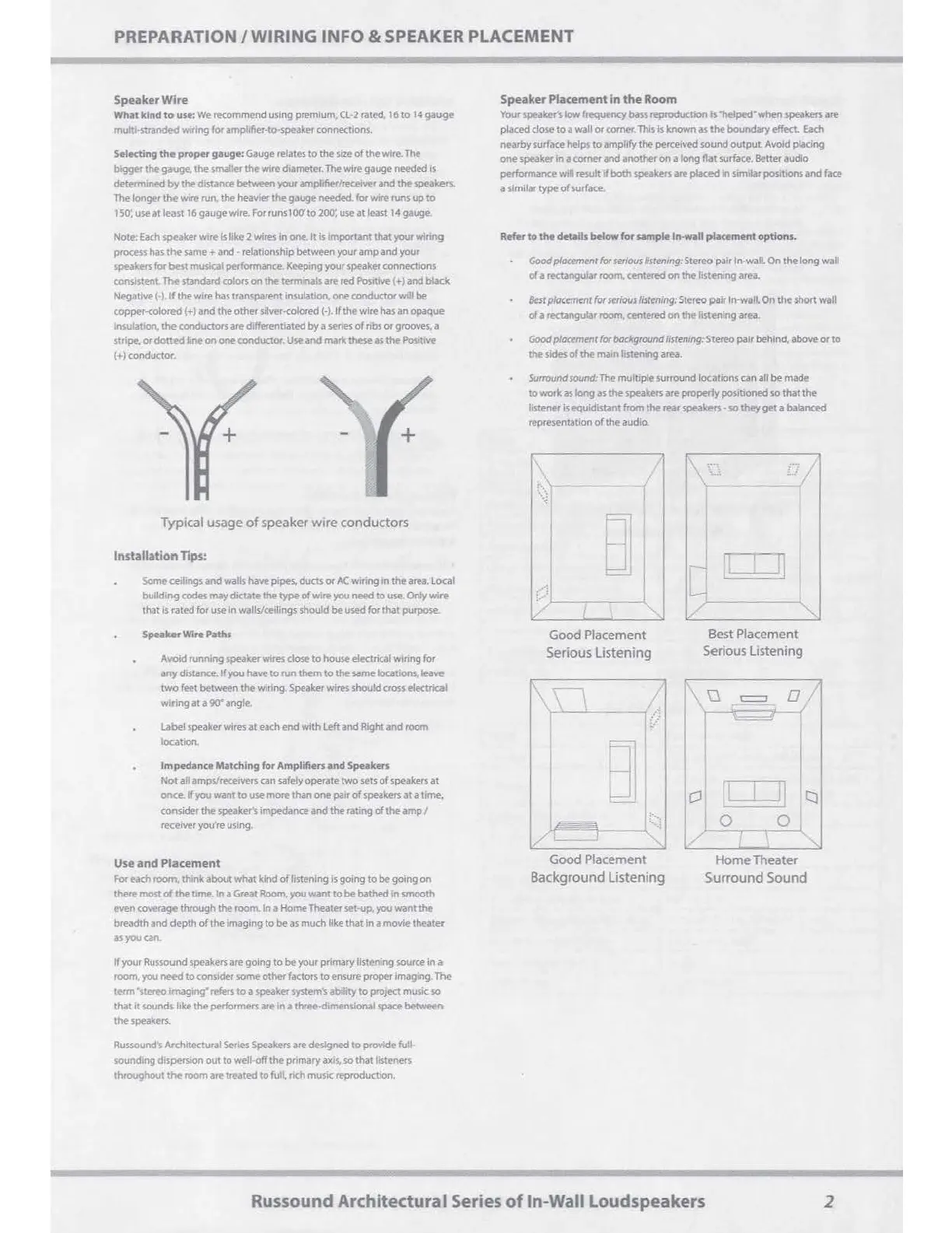
PREPARATION
/WIRING
INFO & SPEAKER PLACEMENT
Speaker Wire
What kind
to
u
..
:we
recommend using premium.
CL-2
rated.
16to
14
gauge
multl-stranded wiring for ampli~er-to-speaker connections.
S•IKting
the
proper gaugl!:
Gauge
relates
to
the
size
of
the
ware.
The
bigger the
!Ji11J9<!,
the smaller the wire di•meter.
The
wire gauge needed
Is
det""'1iM<I
by
the distance between your amplifierirecelller and
the
speakers.
The
longer the wire run. the heavier the gauge needed. for wire runs
up
to
150: use at least
16
gauge wire. Forrunsl 00'
to
200:
use
at
least
14
gauge
Note:
Each
"1)6ker wire
Is
like 2 wires In one.
It
is
Jmpoftant that )"OUf
WIiing
process
has
the
same+
and•
relationship between your amp and your
}peakers for best
mus,cal
performance. Keeping your
speaker
connections
con~stenLlhe standard colors
on
the
tennmals are
red
Positive(+) and black
Negative
(·).If
the wire has transparent insulatlon, one conductor will
be
copper..:olored (+) and the other sll~r-<olored
(-).
If
the wire
has
an opaque
insulation, the conductors
are
differentiated
by
a series
of
nbs
or
grooves, a
stripe.
or
dotted line on one conductor.
Uw
and mark tlwse
as
the Positive
(+) conductor.
Typical usage
of
speaker
wire
conductors
llutallatlon
Tips:
Some ceilings and walls have pipes.
ductS
or
AC
w,nng In the area.
Lcx:al
building codes may dictate the type
of
wire you need
to
use. Only wire
that
is
rated for use In walls/ceilings should be
used
for that fklrpose.
SpealutrWire
Paths
AW>id
running
~ker
wires close
to
house electlical winng for
any distance.
If
you have
to
run thern
to
the
same
locations, leave
two
feet between the wiring.,
Speaker
wires should
cross
electrical
wiring
at
a 90" angle.
label
speaker
wires
at
each
end with Left and Rlghtand room
locatiOn.
tmPl!danc1 Matching
for
Amplifiers a
nd
Sp,,akttt
Not
ail
amps/rece~
can
safely
operate two
sets
of
speakers
at
once.
If
you want
to
use
more than one
pa
Ir
of
speakers
at
a time.
consider the
speaker's
impedance and the r1ting
of
the
amp/
receiver
youie
using.
Use
and
Placement
For
each room. think about
wh.Jt
kind
of
nstening
Is
going
to
be going on
there most
of
the time. In a Great
Room.
you want
to
be bathed In smooth
even
cOW'rage
through the room. In a Home Theater set-up, you want the
breadth and depth
of
the imaging
to
be
as
much like that In a movie theater
as
you
can.
If
your Ru,sound
speakers
are
going
to
be
your primary listening
source
In
a
room.
you
need
to
consider some other factors
to
ensure
proper imaging.
lhe
term "stereo Imaging"
ttfers
to
a
speaker
system's
ability
to
project music so
that
it
sounds like the performers
are
In
a three-dimensk>nal
space
be._,.
the
speakers.
Russound's
Architectural
Series
Speakers
are
designed
to
provide full.
sounding dispersion out
to
well-off the prunary
axis,
so that listeners
throughout
the
room a,e treated
to
full, nch music reproduction.
Speaker Placement in
the
Room
Your
speaker's
1-
freqlJellCY
bass
reproduction
is
"helped"when speaken
are
placed close
to
a wall
or
corner.
This is known
as
the boundary effect.
Each
nearby surface helps
to
amplify the perceived sound
oulpul
Avoid placing
one
speaker
In a corner and another on a long flat surface.
~tter
audio
performance wm result
if
both
speakers
are placed
In
Similar
poSitlons and
face
a similar type
of
surface.
Rm<
to the details below for
Wllf)le
ln--11
placement options.
Good
pla~enl
for
s~ous
listenrng:
Stereo pair In-wall. On the long wall
of a reaangular room. centered on the hstemng
area.
Best
p/a<emenr
for
serious
listemn9:
Stereo
pair In-wall.
On
the
shD!t wall
of
a reaangular room, centered
on
the listening
area.
Good
ploamenr for
background
fisten,ng:
Stereo pa,r behind,
above
or
to
the
sides
of
the mam listening
area.
Surround
sound:
Th,
multtple surround locations
can
all be made
to
work
as
long
as
the
speakers
are properly pesitioned so that
the
listener
Is
N1uidlstant from the rear
}pea~
-
so
they
get a
balanad
representauon
of
the audio.
Good Placement
Serious Listening
Good Placement
Background Listening
[
C:::TI
,,,...-
"·
Cl
Best Placement
Serious Listening
Home Theater
Surround
Sound
Russound Architectural Series
of
In-Wall Loudspeakers
2
Product specificaties
| Merk: | Russound |
| Categorie: | Speaker |
| Model: | IW-620 |
Heb je hulp nodig?
Als je hulp nodig hebt met Russound IW-620 stel dan hieronder een vraag en andere gebruikers zullen je antwoorden
Handleiding Speaker Russound
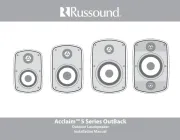
26 Augustus 2025
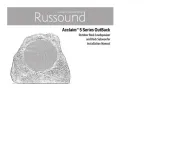
26 Augustus 2025
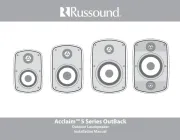
26 Augustus 2025
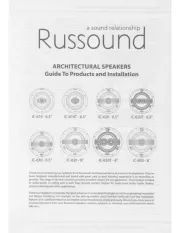
15 Augustus 2025
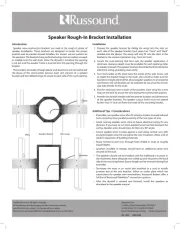
14 Augustus 2025
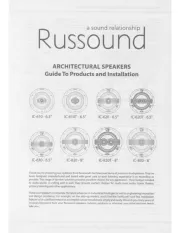
14 Augustus 2025

11 Maart 2025

11 Maart 2025

6 April 2024

6 April 2024
Handleiding Speaker
- Silvercrest
- Argon
- NHT
- OWI
- Audica
- EARISE
- Atomos
- Emphasys
- Deltaco
- Ices Electronics
- OSD Audio
- Milwaukee
- Axis
- Elipson
- Trevi
Nieuwste handleidingen voor Speaker

14 September 2025
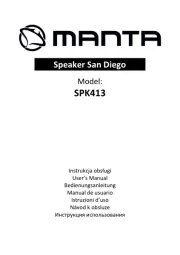
14 September 2025
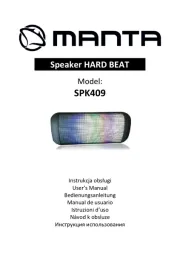
14 September 2025

13 September 2025
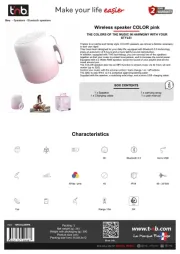
13 September 2025
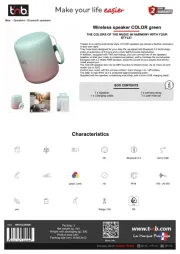
12 September 2025
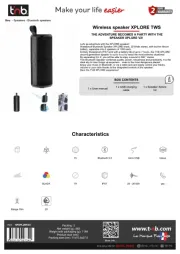
12 September 2025
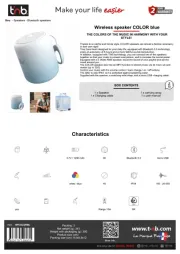
12 September 2025
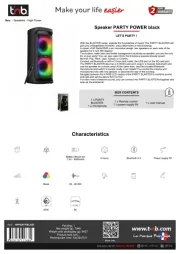
12 September 2025
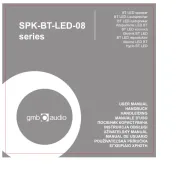
12 September 2025